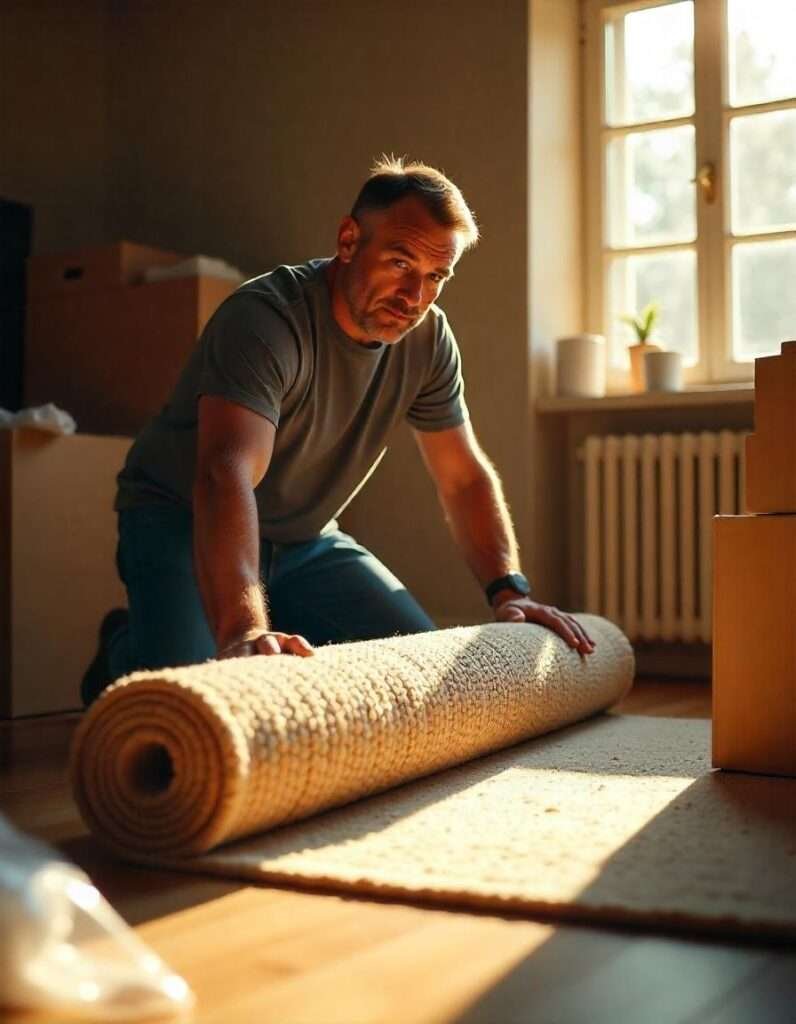
Are you wondering how to keep your beloved rugs in pure condition when they’re not gracing your floors? Whether you’re moving, redecorating, or simply need to store a rug for the season, proper storage is crucial to maintain its beauty and longevity.
In this comprehensive guide, we’ll reveal the secrets of rug storage, ensuring your floor coverings remain as stunning as the day you bought them. Let’s dive into the world of rug preservation and learn how to store rugs like a pro.
Understanding the Importance of Proper Rug Storage
Before we roll up our sleeves and our rugs, let’s discuss why proper storage matters. You might think, “It’s just a rug, right? How complicated can storage be?” Well, you’d be surprised!
Protecting Your Investment
First things first: rugs aren’t cheap. Whether you’ve spent freely on a handmade Persian masterpiece or found the perfect machine-made accent rug for your living room, you’ve invested in your home’s aesthetics and comfort. Proper storage protects this investment, ensuring your rug maintains its value over time.
Think of your rug as a fine wine with proper care, it can age beautifully. But neglect it, and you might end up with something that’s past its prime before its time.
Maintaining Rug Quality Over Time
Rugs are more delicate than they appear. Improper storage can take to lots of issues:
- Fading or discoloration
- Moth damage
- Mold and mildew growth
- Permanent creases or folds
- Fiber breakdown
By storing your rug correctly, you’re not just preserving its appearance but maintaining its structural integrity. This means when you’re ready to roll it out again, it’ll be just as soft, vibrant, and luxurious as you remember.
Preparing Your Rug for Storage

Now that we understand the ‘why,’ let’s get into the ‘how.’ Preparation is key to successful rug storage and it all starts with a good clean.
Cleaning Your Rug Thoroughly
Would you put on dirty clothes after a shower? Of course not! The same principle applies to storing rugs. Here’s a quick cleaning checklist:
- Vacuum both sides of the rug thoroughly.
- Address any stains or spots with appropriate cleaning methods.
- For valuable or antique rugs, consider professional cleaning.
- Ensure the rug is completely dry before storage.
Remember, storing a dirty rug is like sending an invitation to pests and mold. A clean rug is the source of happiness.
Treating for Pests and Mold
Speaking of uninvited guests, let’s talk prevention. Moths and other pet lovers love to munch on natural fibers, while mold and mildew thrive in damp conditions.
Consider using cedar blocks or lavender sachets as natural pest resistance. For extra protection, especially for valuable rugs, talk to a professional about moth-proofing treatments.
As for mold, the key is moisture control. We’ll dive deeper into this when we discuss storage locations. But for now, remember dry rugs are happy rugs.
Choosing the Right Storage Location
Location, location, location! It’s not just important in real estate rather it’s crucial for rug storage too.
Climate-Controlled vs. Non-Climate-Controlled Spaces
If you have the option, always choose a climate-controlled space for rug storage. This means a place where temperature and humidity remain relatively constant. Why? Because fluctuations in temperature and humidity can create havoc on rug fibers.
Imagine your rug as a sponge. In humid conditions, it absorbs moisture, potentially leading to mold growth. In dry conditions, it can become brittle. A climate-controlled space helps avoid these extremes.
Avoiding Damp or Humid Areas
If a climate-controlled space isn’t an option, at least avoid damp or humid areas. This rules out most basements, garages, and attics. Look for a dry, cool spot in your home perhaps a spare room or a closet on an upper floor.
Remember, your rug’s worst enemies are moisture and extreme temperatures. By choosing the right storage location, you’re already halfway to storage success.
Proper Techniques for Storing Different Rug Types
Not all rugs are created equal, neither are their storage needs. Let’s break down the best practices for different rug types.
Rolling vs. Folding: What’s Best for Your Rug?
Here’s a general rule of thumb: when in doubt, roll don’t fold. Rolling helps prevent permanent creases and keeps the rug’s backing from cracking.
To roll your rug:
- Start with the rug face-up.
- Roll in the direction of the pile.
- Keep it loose because tight rolls can damage the backing.
But what about smaller rugs? For very small rugs think bath mat size, folding might be okay for short-term storage. Just be sure to pad the fold with acid-free tissue paper to prevent sharp creases.
Storing Antique and Delicate Rugs

If you’re lucky enough to own an antique or particularly delicate rug, it deserves extra care. Here are some special factors to consider:
- Always roll these rugs and never fold them.
- Use a protective tube to maintain the rug’s shape.
- Consider professional storage for extremely valuable pieces.
- Avoid plastic coverings which can trap moisture.
Remember, when it comes to antique rugs, it’s better to err on the side of caution. When in doubt, consult a professional rug expert.
Essential Materials for Rug Storage
Now that we know how to roll our rugs, let’s talk about what we should roll them in.
Protective Wraps and Covers
Think of a protective wrap as your rug’s sleeping bag. It shields your rug from dust, light, and pests. But choose wisely. Here are some options:
- Cotton or muslin sheets: Breathable and natural.
- Acid-free paper: Great for preventing color transfer.
- Specialized rug bags: Designed specifically for rug storage.
Avoid plastic at all costs. It might seem like a good idea, but plastic can trap moisture which leads to mold and mildew growth.
Support Tubes and Padding
A support tube is like a spine for your rolled rug. It prevents the rug from developing a permanent curl. Here’s what you need:
- A sturdy cardboard tube or PVC pipe
- Acid-free tissue paper for padding
Wrap your rug around the tube, then wrap the whole thing in your chosen protective cover. It’s like a rug burrito.
Long-Term Rug Storage Tips
So, you’ve cleaned your rug, rolled it properly, and found the perfect storage spot. Job done, right? Not quite! Long-term storage requires ongoing care.
Regular Check-ups and Maintenance
Out of sight shouldn’t mean out of mind. Set a reminder to check on your stored rugs every few months. Look for signs of:
- Pest activity
- Mold or mildew
- Fading or discoloration
Catching these issues early can save your rug from permanent damage.
Rotating Stored Rugs
If you’re storing multiple rugs, consider rotating their positions every few months. This prevents any one rug from bearing the brunt of less-than-ideal conditions like being on the bottom of a stack.
Think of it like rotating your tires, it ensures even wear and tear, or in this case, even preservation.
Common Mistakes to Avoid When Storing Rugs

We’ve covered the dos, but what about the don’ts? Here are some common rug storage mistakes to avoid:
- Storing rugs in plastic
- Placing heavy objects on stored rugs
- Ignoring pest prevention
- Forgetting to clean before storage
- Storing in damp or humid conditions
- Folding large rugs
- Using newspaper as padding
By making clear of these mistakes, you’re setting your rugs up for storage success.
FAQs
How long can I store my rug?
With proper preparation and storage conditions, you can store a rug for several years without significant deterioration. However, it’s best to check on stored rugs periodically.
Can I store my rug in the garage?
It’s not recommended. Most garages aren’t climate-controlled and may be prone to moisture, temperature fluctuations, and pests. These conditions can damage your rug over time.
Do I need to clean my rug after taking it out of storage?
Yes, it’s a good idea to at least vacuum your rug thoroughly after storage. If it’s been stored for a long time, consider professional cleaning.
What’s the best way to store an outdoor rug?
Clean it thoroughly, ensure it’s completely dry, then roll and store it similarly to indoor rugs. However, outdoor rugs are often more resistant to moisture, so they may tolerate less-than-ideal conditions better.
Can I use mothballs to protect my stored rug?
While mothballs can deter pests, they’re toxic and leave a strong odor. Natural alternatives like cedar or lavender are safer and more pleasant options for pest prevention.
Conclusion: Mastering the Art of Rug Storage
Congratulations! You’re now equipped with the knowledge to store your rugs like a pro. Remember, proper rug storage is an investment in the longevity and beauty of your floor coverings. By following these guidelines, you’re ensuring that when you next unroll your rug, it’ll be just as beautiful as the day you stored it.
Rug storage might seem like a lot of work, but trust me, your future self will thank you. After all, a well-preserved rug is not just a piece of decor rather it’s a piece of your home’s history ready to make memories for years to come.
So, the next time you need to store a rug, don’t just roll it up and hope for the best. Take the time to do it right. Your rugs will reward you with lasting beauty and quality. Happy storing!
